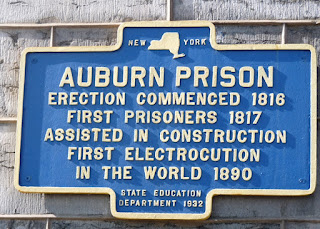In 1793 when Revolutionary War veteran Colonel John Hardenbergh, the first documented white settler in the Finger Lakes area, arrived in the Auburn, NY region it was home of the Haudenosaunee and was called “Ahskuby”. He and his two African American slaves, Kate and Henry, established the settlement of Hardenbergh’s Corners and two mills. The village was renamed Auburn in 1805. Local factories provided jobs for the inhabitants and with the 1825 opening of the Erie Canal job opportunities grew. Because of employment, access to transportation and proximity to Canada Auburn was a draw for free and fugitive African Americans, abolitionists and liberal thinkers. www.iloveny.com
The city has been designated a Preserve America Community for its protection of the culture and heritage and development and preservation of the neighborhoods. Auburn has done an outstanding job of protecting and preserving and because of its efforts the sites cover an intriguingly diverse range of themes and time periods. www.preserveamerica.gov
Auburn is referred to as the “prison city” because it is home to the Auburn Correctional Facility. Auburn Prison was created in 1816 to serve as a model for prisoner treatment and for a fee visitors could view the prisoners. On August 6, 1890 the world’s first execution by electric chair took place at the prison. It was also the first botched execution as the first jolt of electricity failed and a second was required to accomplish the deed.
In 1854 George Washington, an escaped slave who had served ten years in the prison, was to be discharged and returned to slavery due to the 1950 Fugitive Slave Law. A crowd gathered and managed to free him and send him to Canada. This was the final time the Fugitive Slave Law was invoked in central New York. www.tourcayuga.com
Auburn at Prison City Pub and Brewery, located nearby, has an award-winning, on-site, craft brewery. Food is sourced from local suppliers and the menu offers creative gourmet pub food. Delicious options range from poutine to shrimp and grits. www.prisoncitybrewing.com
The Richardsonian Romanesque Willard Memorial Chapel is a unique jewel in a crown filled with them. It features the only complete and unaltered Tiffany chapel in existence. From 1892-4 the Louis C. Tiffany and Tiffany Glass and Decoration Co. completed the interior. On view are 14 opalescent nave windows, nine Moorish-styledchandeliers, inlaid oak furnishings, 9 paneled rose window, jeweled octagonal pulpit and a ceiling with gold leaf stencils. The chapel was commissioned by the daughters of Dr. and Mrs. Willard in their memory. It was placed on the National Register of Historic Places in 1989.A guided tour, “The Tiffany Treasure of the Great Lakes”, is offered. Do not miss this site! www.willard-chapel.org
Harriet Tubman National Historical Park interprets Harriet’s life after she moved to Auburn in 1859. She spent the final 54-years of her life here and continued her fight for civil and human rights. Tours of the location include the Harriet Tubman Residence, the Harriet Tubman Home for the Elderly, the AME Zion Church, a museum and 20-minute orientation in the Visitor Center.
New York Senator William H. Seward sold Tubman the 7-acre property, after she refused to accept it as a gift, for $1,200. In 1896 she added 25-acres to her property in order to establish a home for the elderly. In 1886 her original wooden house burned down and was replaced by her second husband, Nelson Davis, with a brick residence. Tubman deeded her property to the AME Zion Church to ensure that the home would continue. She died in 1913 and was buried in Fort Hill Cemetery. AME Zion Church manages the site and tours are masterfully conducted by Rev. Carter of Harriet Tubman Home, Inc. www.harriet-tubman.org, https://www.nps.gov/hart
William H. Seward was Lincoln’s Secretary of State and was severely wounded in the assassination plot. He and his wife were staunch abolitionists and ran an Underground Railroad station from their home and it was they who sold the property to Harriet Tubman. Seward was significant in the writing of the Emancipation Proclamation and a copy, with his edits, is displayed in his home. Seward paid the bail money for the Jerry Rescuers and defended an African American murderer in court invoking the insanity plea for one of the first times in an American court. Seward’s parents were slave owners and he said that he came by his abolitionist beliefs through his enjoyment of time spent with the slaves. He realized they were treated poorly and resolved to do something about it.
The Federal-style Seward House was constructed in 1817, one of the earliest brick homes in the city. Originally it was a 10-room townhouse. With additions the home now has more than 30 rooms. House tours include rooms furnished with some family possessions. The mansion was visited by 6 presidents and countless freedom seekers in transit to Canada. Slaves were hidden in the basement kitchen and a room over the woodshed. The kitchen interprets the Seward’s UGRR experiences. It is believed that his wife Francis ran the station because Seward was so often in Washington. www.sewardhouse.org
The Sewards and Harriet Tubman are buried in Fort Hill Cemetery. The 22-acre cemetery was dedicated in 1852 but served the Cayuga Indians as a fortified hill in the mid-1500s. A 56-foot obelisk sits in the center of the mound to honor Cayuga Chief “Talgahyeetah” Logan. www.forthillcemetery.net
The 1851 Springside Inn should be your only choice for accommodations in Auburn. This luxurious 7-room inn sits on the shore of Lake Owasco and has hosted Us Presidents, the rich and famous and NY Senator Hillary Clinton. It is believed to have been active in the UGRR. A continental breakfast is included as is free Wi-Fi, parking and personalized service. The on-site Oak and Vine Restaurant incorporates locally sourced foods into their creative menu. www.springsideinn.com/springside-inn-on-owasco-la











No comments:
Post a Comment